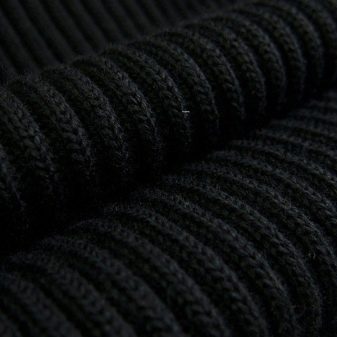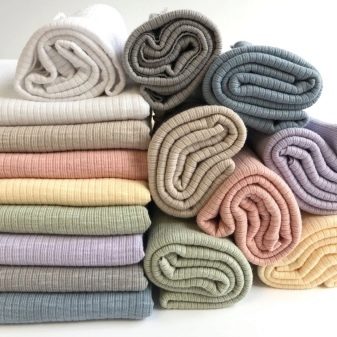All about the noodle fabric

Products made of knitted materials are distinguished by quality, pleasant texture, positive external characteristics. "Noodles" is a material that is soft to the touch and pleasant to the body. How it looks, the history of the appearance of the material, as well as the most popular ways of caring for products will be discussed in the article.


What it is?
“Noodle” fabric is a fabric for the production of which natural or artificial raw materials can be used. The material has a characteristic scar, which is formed by alternating purl and front loops. The composition may contain cotton or wool, as well as acrylic, elastane or viscose. That is, the composition of the material is varied, using natural or artificial fibers.
Knitted fabric can be conditionally subdivided into types with different composition of raw materials.
- Sandra. It is a fabric that is soft and pleasant when touching the body, which stretches and stretches well. On the front side, the canvas is smooth, with an almost indistinguishable small scar. The most common products are made from sandra jersey. The raw materials include polyester (about 67%) and viscose, and stretch fibers are also used.


- Attracts attention and material kashkorse, combining excellent quality, naturalness and affordable cost. The fabric has a pronounced vertical rib with intertwining front and back loops in a ratio of 2x2 or 3x3. It is a soft and dense fabric with excellent stretch properties. When knitting, cotton is used with the addition of viscose, elastane and polyester.

- To make the canvas outwardly more interesting allows the use of metallized threads. "Noodles" with lurex threads are usually used for sewing fancy products.
This thread is also used for sandra and kashkorse materials.


- Ribana or just an elastic band. The material is distinguished by high elongation, while the canvas will perfectly keep its shape. In the classic version, the ribana is made in the form of a small rib with 1x1 loops. In the composition of such material, viscose, polyester and elastane are often used. And also there are options with a fleece in the manufacture of products for the cold season.


- A popular type of knitted noodles with a strip width of more than 3 loops. In this case, the composition of the canvas can be different. Outwardly, such products can be compared to hand-knitted items.


The color of such a canvas can also be varied, although more often you can find products in a neutral range. Basic shades such as milky, white, gray, beige or burgundy are popular. Knitted products are in high demand. Products made from this material can be called universal. Clothes made from such a canvas will be appropriate at work, at business meetings, in everyday life.
The advantages of this material include practicality, good extensibility, and ease of use. Products made from noodles stretch well, they perfectly fit the figure and visually make it slimmer. Pilling is not formed on high-quality noodle products, which greatly increases the wear resistance of the products. The knitwear keeps its color well even after numerous washes.
After washing, the products practically do not wrinkle and do not shrink. But with frequent wear or with improper care of things, they can still stretch after a while.


History of origin
As soon as knitting machines were used in production, knitwear appeared. Back in the 15th century, Italian manufacturers released material that was used as demonstration models during the show. The fabric soon became so popular that knitwear could be seen in almost every family. But knitwear with embossed ribs was first produced in France. It happened in the middle of the XX century. The fabric is produced on special machines, and not on weaving machines. The canvas is made by alternating purl and front loops in a ratio of 2x2 or 3x3. Stripes with a width greater than the specified parameters, such as an English rubber band, can rarely be used.
Usually, such material is produced in one color; printed canvases are very rare. The dyeing process is carried out at the final stage of production. In this case, environmentally friendly pigments are used. In the production of mottled material, threads are used that are pre-dyed. The most popular are products made in Turkey, Italy or Korea. They are made from wool, cotton and viscose with the addition of a small amount of elastane, which increases the elasticity of the fabric.


Applications
Basically, they make clothes from noodles. The composition of finished products may be different, and the seasonality of things will also depend on it.
- You can sew a comfortable and practical dress from the noodles, which will be an excellent option for going to the movies, for work, or a business meeting.
- Tracksuits and home clothes are sewn from comfortable linen.
- A jacket made of such a canvas, a warm sweater or a knitted turtleneck with the addition of angora will complement the fashionable look.
- Knitted skirts are popular. They perfectly fit the figure.
- Men also do not bypass products made of this material. For men, durable and comfortable T-shirts, turtlenecks and sweaters are sewn from it.
- Used "noodles" and when sewing children's products. Usually for this they take canvases made from natural materials. Kids will be happy to wear soft and comfortable suits, blouses and pants.
This multifunctional material is used for sewing products of any style.In addition to sewing garments, the material is also suitable for finishing finished products.
Noodle cuffs and neckline will perfectly complement any other material ensemble.



Care Tips
Products made from "noodles" look elegant and original. To make these things last longer, they need proper care. When purchasing a thing, you need to make sure that the product has a label, where there is a description of the composition, as well as recommendations for caring for it. In the absence of such a label, it is recommended to take care actions according to the advice of specialists.
- It is recommended to wash things from such jersey at a water temperature not exceeding 40 degrees. You should first sort things by color, separating light-colored items from dark items.
- During washing, take a gel or other liquid detergent. At the same time, aggressive agents, powders and bleaches are not suitable for washing such products.
- Better to wash by hand. If they do this in a washing machine, then they set the delicate mode, and wash at the minimum speed of the unit.
- Do not twist things too much, they are carefully wrung out and sent to dry.
- For drying, the product is straightened and laid out in a room with good air circulation. When drying, knitwear should not be hung on a hanger, otherwise they will lose their original shape and stretch out.
- After washing, the product may not be ironed, but if necessary, things are ironed from the inside out with an iron, trying to keep the heating temperature below 130 degrees.
- They store the washed things, turned them inside out, folded. Noodle products are not hung on a hanger.
- And also it is not recommended to give products from this material to dry cleaning.
Compliance with these recommendations will allow you to keep your favorite things in the best possible way for a long period, avoiding stretching or deformation.










